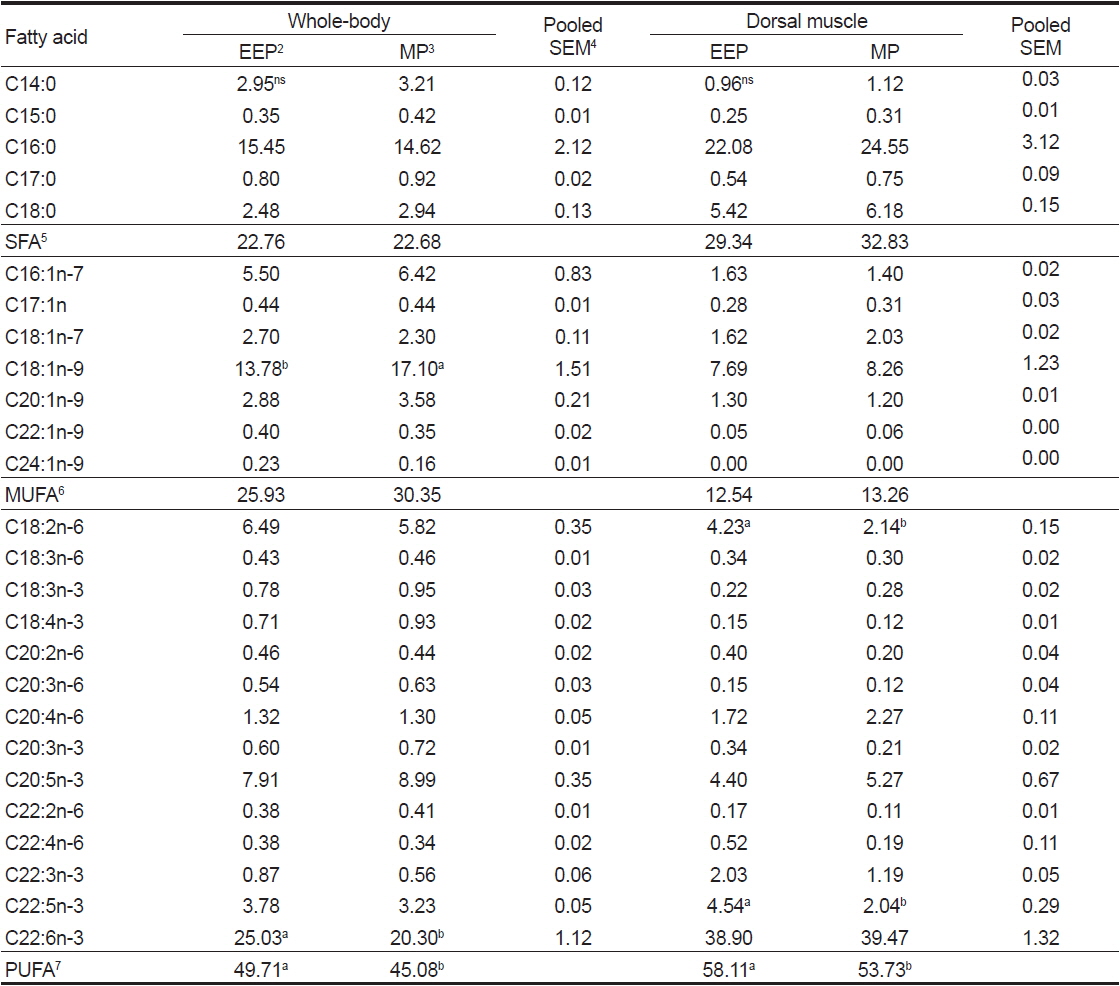



This study was conducted to compare an experimental extruded pellet (EP) and raw fish-based moist pellet (MP) on growth performance, whole-body and dorsal muscle composition, and textural properties of dorsal muscle for olive flounder Paralichthys olivaceus. Four groups of 8,000 fish (initial mean weight 27.1±0.05 g) per concrete tank (10×10 m) were fed the experimental diets for 16 months. After the feeding trial, no significant differences were observed in final mean body weight, weight gain, specific growth rate, feed intake, survival, and condition factor between EP and MP groups. However, feed efficiency of fish fed the EP was significantly higher than that of fish fed the MP. Moisture content in the whole-body of fish fed the MP was significantly higher than that of fish fed the EP. Significantly higher contents of polyunsaturated fatty acid (PUFA) in whole-body and dorsal muscle were observed in fish fed the EP compared with fish fed the MP. Any notable differences in amino acid contents or textural properties of the dorsal muscle were not observed in fish fed either the EP or the MP. The results of this study indicated that the EP could be developed to replace MP for the market size of production in olive flounder without the adverse effects on growth performance. Formulation of the EP could be used as a practical feed for olive flounder.
양식어종에 적합한 고효율 배합사료를 개발하기 위해서는 대상어종의 영양소 요구량, 사료원료의 소화율, 영양소 대사 및 사료의 적정 단백질/에너지 비율(protein/energy ratio) 등 여러 연구가 종합적으로 이루어 져야 한다. 외국의 경우 주요 양식어종에 대한 영양소 요구량이 어종별로 규명되어 있다(NRC, 2011). 넙치의 경우 단백질요구량 연구(Kim et al., 2002), 필수 아미노산요구량 및 대사 연구(Alam et al., 2002; Kim et al., 2012; Kim et al., 2013), 기호성 및 면역력 향상을 위한 첨가제 연구(Kim et al., 2009; Kim et al., 2010; Kim et al., 2013), 주요 원료의 이용성 및 소화율 연구(Choi et al., 2004; Pham et al., 2007; Ye et al.,2011) 및 단백질/에너지 비율(Kim et al., 2004) 등 다양한 연구가 활발히 진행되었으며, 최근에는 이러한 연구 결과를 바탕으로 다양한 실험용 배합사료를 제조하여 실제 양식장에서 습사료(moist pellet, MP)와 비교 사육실험을 통해 성장률, 어체품질 및 사료효율 등을 평가하여 습사료 보다 우수한 고효율 배합사료(extruded pellet, EP)를 개발하기 위한 연구들이 진행되고 있다(Kim et al., 2005; Kim et al., 2006; Kim et al., 2008; Kim et al., 2009; Kim et al., 2014). 하지만 대부분의 연구들이 겨울철에 수온이 낮은 관계로 봄에서 겨울 초까지 진행되고 있으며, 상품크기 (1 kg 이상)까지 키우지 못하고 1 kg 미만에서 중단되어 1년 이상 장기간에 걸쳐 상품크기까지 키웠을 때 배합사료와 습사료가 어떠한 차이를 보이는지에 대한 자료는 부족한 실정이다. 또한 지금까지 습사료와 배합사료 비교 연구들을 살펴 보면, 치어기, 육성기, 성어기 등으로 나누어 실험이 진행되거나 1년 내내 지하해수가 풍부하여 겨울철에도 성장 실험을 수행할 수 있는 제주 지역에 국한되어 수행되었으며, 성장 결과에 있어서는 대부분 습사료와 비슷하거나 다소 낮은 결과를 보이고 있다(Kim et al., 2009; Kim et al., 2014).
넙치 치어기부터 성어기까지 자연수온에 의존하여 1년 이상 배합사료와 생사료를 급여하여 1 kg 이상까지 사육하면서 성장, 사료효율, 체조성 및 어체품질에 미치는 영향을 평가하고자 수행되었다.
실험사료의 조성은 Table 1에 제시되어 있으며, 원료의 일반 성분, 아미노산 및 지방산 조성의 분석결과는 Table 2, 3, 4에 나타내었다. 실험사료 조성은 넙치 배합사료 영양요구량 및 이전 실용배합사료 효과 시험 연구결과를 참고하여 설계하였다 (Kim et al., 2004; Kim et al., 2006; Kim et al., 2009; Kim et al., 2012). 단백질원으로는 어분, 어류가수분해단백, 크릴분, 오징어분, 발효대두박, 농축대두단백 및 밀글루텐을 사용하였고, 지질원으로는 어유, 탄수화물원으로는 소맥분을 사용하였다. 이외에 사료첨가제로서 비타민 및 미네랄 혼합제, 비타민 C, 일인산칼슘, 유화제, 타우린, 베타글루칸, 효소제, 생균제 등을 사용하였다. 주 단백질원으로 사용된 어분은 소화율 평가 및 사육효과시험을 거쳐 선택하였다. 배합사료(EP)는 원료를 혼합한 후 익스트루더(Bühler, Swiss)를 이용하여 압출·성형하였으며, 사료크기는 직경 3-15 mm로 사료회사에서 제조하였다. 대조사료로 사용된 습사료(MP)는 냉동된 메가리, 곤쟁이 및 잡어 등의 생사료와 분말사료를 9:1의 비율로 혼합하여 MP사료를 제조하였다.
[Table 1.] Formulation and proximate compositions of the experimental diets1
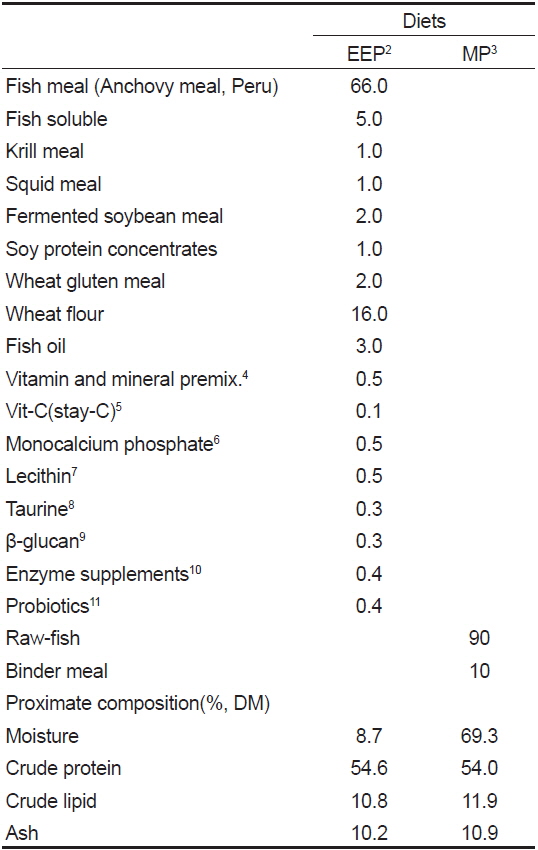
Formulation and proximate compositions of the experimental diets1

Proximate analysis of major ingredients used in the extruded pellet for olive flounder Paralichthys olivaceus
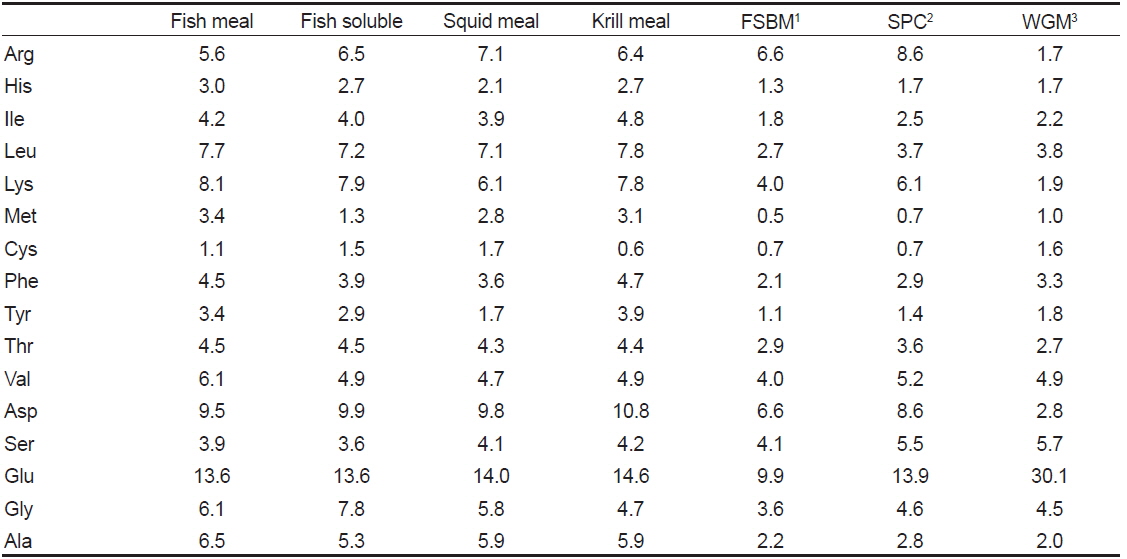
Amino acid contents of major ingredients used in the extruded pellet for olive flounder Paralichthys olivaceus (% to total amino acids)

Fatty acid composition (%) of major ingredients used in the extruded pellet for olive flounder Paralichthys olivaceus
사양실험에 사용된 실험어류는 전남 완도에 위치한 육상수조 넙치 양식장에서 구입하여 운송되었으며, 실험환경에 적응할 수 있도록 순치시킨 후 사료공급실험에 사용되었다. 예비사육 후 실험어류(초기 평균무게: 27.1±0.05 g)는 총 8개의 10×10 m 콘크리트 수조에 각 수조 당 8,000 마리씩 무작위로 선택하여 배치되었다. 사료공급실험은 실험구당 4 반복구를 두었으며, 사육수의 유수량은 1일 20-24 회전으로 조절되었고, 모든 실험수조에 용존산소 유지와 원활한 사육수 순환을 위하여 에어스톤을 설치하였다. 사육기간 동안의 수온은 최저 9.5℃에서 최고 26℃ 범위로 평균 수온은 17.2±2.9℃로 자연수온에 의존되었다. 실험은 16개월 동안 진행되었으며, 실험사료는 1일 1회 또는 2회 어체중의 1-2.5%를 만복으로 급여하였다.
사료공급 실험 후, 어류의 최종 평균무게를 측정하여 증체율(Weight gain), 사료효율(Feed efficiency), 일간성장률(Specific growth rate), 단백질이용효율(Protein efficiency ratio) 및 생존율(Survival)을 계산하였다. 최종 무게측정 후, 분석을 위해 각 수조마다 30마리씩 무작위로 선별하여 마취용액(MS-222,100 mg/L)으로 마취시킨 후 −70℃ 냉동고에 보관 후 분석되었다.
실험사료, 전어체 및 등근육의 일반성분 분석을 위해 AOAC (2000) 방법에 따라 수분은 상압가열건조법(125℃, 3 h), 조회분은 직접회화법(550℃, 12 h)으로 측정하였고, 단백질은 자동 조단백분석기(Bunchi B-324/435/124, Switzerland; Metrohm 8-719/806, Switzerland)로 분석되었으며, 지방은 Folch et al.(1959)의 방법에 따라 Soxhlet 추출장치(Soxhlet heater system C-SH6, Korea)를 이용하여 분석되었다.
지방산 분석은 각 사료구별 전어체 및 등근육을 동결건조하고 분쇄한 시료 3 g에 대하여 4배량의 chloroform : methanol 혼합용매(2:1, v/v)를 가하여 homogenizer로 2분간 교반한 후, 여과하여 얻은 여액을 플라스크에 넣고 evaporator로 용매를 제거하여 지질을 추출하였다. 추출한 지질은 14% BF3-methanol(Sigma Chemical Co., USA) 2 mL를 가하고 30분간 85℃에서 가열시킨 다음, 석유 ether로 추출하여 지방산 분석용 시료로 사용하였다. 지방산은 HP-INNOWax capillary column (30 m×0.32 mm i.d., film thickness 0.5 μm, Hewlett-Packard, USA)이 정착된 gas chromatography (HP6890, USA)로 분석하였으며, carrier gas로 helieum을 사용하였다. Injector와 detector(FID) 온도는 각각 250℃, 270℃로 설정하였고, oven 온도는 170℃에서 225℃까지 1℃/min 증가시켰다. 각 지방산은 동일조건에서 표준지방산 methyl ester mixture (Sigma Chemical Co., USA)와 retention time을 비교하여 동정하였으며 함량은 각 peak의 면적을 상대 백분율로 나타내었다.
구성아미노산 분석은 각 사료구별 전어체와 등근육 부위를 동결건조하고 분쇄한 시료 0.5 g을 정밀히 취하여 시험관에 넣고 6 N-HCl 15mL를 가하여 감압밀봉한 후 110℃의 dry oven에서 24시간 이상 동안 산가수분해시켰다. Glass filter로 분해액을 여과하고 얻은 여액을 55℃에서 감압농축 하여 염산과 물을 완전히 증발시킨 다음, 농축된 시료를 sodium citrate buffer(pH 2.20)로 25 mL 정용플라스크에 정용하여 0.45 μm membrane filter로 여과 한 시료액을 아미노산 자동 분석기(Biochrom 30, Biochrom Ltd., England)를 사용하여 분석하였다. Cation separation column (oxidised feedstuff column, 4.6 mm×200 mm)을 사용하였고 0.2 M sodium citrate buffer (pH 3.20, 4.25)와 1.2 M sodium citrate buffer (pH 6.45) 및 0.4 M sodium hydroxide solution을 이동상으로 사용하였다. 이동상의 유속은 0.42 mL/min, ninhydrin 용액의 유속은 0.33 mL/min, column 온도는 48-95℃, 반응온도는 135℃로 설정하여 분석하였다.
각 사료구별 같은 부위의 넙치 등근육을 절편 (가로 1 cm, 세로 1 cm, 두께 0.5 cm)으로 만들어 호일에 싼 뒤 얼음 위에 1시간정도 올려 둔 것으로 물성측정을 하였다. 등근육 절편은 Rheometer (COMPAC-100, Sun Scientific. Co., Japan)를 이용하여 응집성(cohesiveness), 경도(hardness), 부착성(adhesiveness) 및 강도(strength)를 측정하였다. 측정조건은 plunger diameter 10 mm, load cell 2 kg (No 25, ø15), table speed 120 mm/min으로 하였고, 모든 측정은 5회 반복 측정하여 평균값으로 나타내었다.
실험사료군의 배치는 완전확률계획법(Completely randomized design)에 따라 실시하였고, 성장 및 분석결과는 SPSS(Version 12.0) 프로그램을 이용하여 One-way ANOVA로 통계 분석되었다. 실험 데이터 값의 유의차는 Duncan’s multiple test (
본 연구에서는 고품질 배합사료를 개발하기 위해 다양한 동·식물성 단백질원료에 대한 성분을 분석하고 이 결과를 바탕으로 배합비를 설계하였다. 주요 단백질원료에 대한 일반성분 분석결과는 Table 2에 나타내었다. 일반성분 분석결과, 조단백질 함량에서는 식물성단백질원료인 밀글루텐(wheat gluten meal)이 83.7%로 가장 높았고, 오징어분(squid meal, 74.6%), 어류가수분해단백(fish soluble, 74.5%), 농축대두단백(soy protein concentrates, 74.1%) 순이었다. 조지방 함량은 어류가수분해단백 원료가 21.7%로 가장 높았고, 크릴분(krill meal) 11.4%, 어분 7.3%, 오징어분 3.8% 순이었으며, 식물성 단백질원료인 발효대두박, 농축대두단백 및 밀글루텐에서는 1.0% 이하로 낮게 분석되었다.
주요 단백질원료에 대한 아미노산 조성 분석결과는 Table 3에 나타내었다. 동물성 단백질원료(어분, 어류가수분해단백, 오징어분 및 크릴분) 및 식물성 단백질원료 (발효대두박, 농축대두단백 및 밀글루텐)의 아미노산 분석결과를 비교해 보면 동물성 단백질원료는 대부분의 아미노산이 균일하게 차이를 보이지 않았으나, 식물성 단백질 원료는 대부분의 아미노산이 동물성 단백질원료와 비교하여 매우 낮은 것을 알 수 있었다. 특히 밀글루텐 원료는 필수아미노산의 함량이 낮고 비필수아미노산 중 하나인 glutamic acid의 함량이 전체 아미노산 중 30.1%를 차지하였다.
주요 단백질원료에 대한 지방산 조성 분석결과는 Table 4에 나타내었다. 동물성 단백질원료(어분, 어류가수분해단백, 오징어분 및 크릴분)가 식물성 단백질원료(발효대두박, 농축대두단백 및 밀글루텐)에 비해 C20:4n-6 (arachidonic acid), C20:5n-3 (eicosapentaenoic acid, EPA) 및 C22:6n-3 (docosa hexaenoic acid, DHA)와 같은 고도불포화지방산(polyunsaturated fatty acid, PUFA) 함량이 높았으며 식물성 원료에서는 PUFA가 검출되지 않았다.
넙치용 고효율 배합사료를 개발하기 위해 실험용 배합사료(experimental extruded pellet, EP) 및 습사료(moist pellet, MP)를 공급하여 16개월 동안 사육한 실험결과는 Table 5에 나타내었다. 최초 평균체중이 27 g이던 것이 16개월 후 평균체중 1 kg 이상 성장하였으며, 증체율은 실험용 배합사료 실험구(EEP)가 3,671%로 생사료(MP) 실험구의 3,612%와 비교하여 유의적인 차이는 보이지 않았으나 높은 증체율을 보였다. 생존율에 있어서도 EP 실험구가 80.5%로 MP 실험구 75.9% 보다 높게 나타났다. 사료효율은 EP 실험구가 88.1% (사료계수 1.14)로 MP 실험구의 79.3% (사료계수 1.26) 보다 높은 효율을 보였다. EP 실험구에 비하여 MP 실험구의 낮은 사료효율은 이미 기존의 연구들에서도 보고된 바 있으며(Kim et al., 2006; Kim et al., 2012), 이는 MP 사료의 경우 사료를 섭취하는 동안 수중으로 유실되는 양이 EP사료에 비하여 많기 때문으로 판단된다. 비만도에 있어서는 모든 실험구에서 유의적인 차이를 보이지 않았다. 생존율에 있어서는 EP 실험구가 80.5%, MP 실험구가 75.9%로 전체적으로 낮은 생존율을 보였다. 실험 기간 중 환경 변화를 살펴보면, 가장 높은 수온은 8월에 22.5±3.5℃ (12.0-26.0℃)로 나타났으며, 가장 낮은 수온은 2월에 10.2±0.38℃ (9.5-10.7℃)였다. 9-11월에는 16-22℃범위로 넙치 성장에 적합한 수온이 유지되었고, 7-8월에는 남서풍으로 인해 냉수대가 2 차례 정도 나타났다. 8-10월 사이에는 적조는 나타나지 않았으나, 높은 파도로 인한 탁도 증가, 고수온으로 인한 먹이 절식 및 어병 발생으로 20-25%의 폐사가 발생하였다. 상기 결과를 토대로 상품크기까지 성장함에 있어 EP가 MP 사료의 성장 및 사료효율과 비교하여 대등한 성적을 보임으로써 산업화 보급에 전혀 손색이 없는 것으로 나타났다.
[Table 5.] Growth performance of olive flounder Paralichthys olivaceus fed the experimental diets1
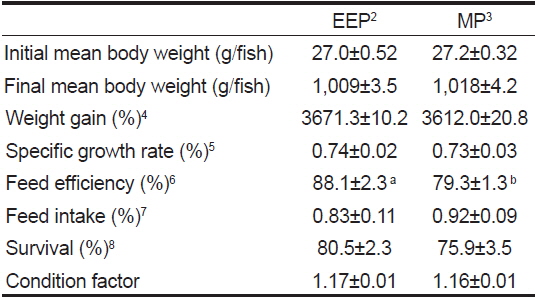
Growth performance of olive flounder Paralichthys olivaceus fed the experimental diets1
배합사료와 습사료를 공급한 넙치의 전어체 및 등근육의 일반성분 분석 결과는 Table 6에 나타내었다. 전어체에 있어서 조단백질, 조지질, 회분은 EP 실험구 및 MP 실험구 간에 차이를 보이지 않았으나, 수분은 MP 실험구가 EP 실험구 보다 유의적으로 높은 결과를 보였다. 일반적으로 EP사료는 8-10% 수분을 포함하고 있으나 MP사료는 65-75% 수분을 포함하고 있다. MP사료의 수분함량이 전어체의 수분함량에 영향을 미친 것으로 사료된다. 등근육에서 일반성분은 실험구간에서 유의적인 차이를 보이지 않았다.

Proximate composition (%) of the whole-body and dorsal muscle for olive flounder Paralichthys olivaceus fed the experimental diets1
배합사료와 습사료를 공급한 넙치의 전어체 및 등근육의 지방산 조성은 Table 7에 나타내었다. 전어체의 포화지방산(saturated fatty acid, SFA)으로는 공통적으로 palmitic acid (C16:0)의 함량이 가장 많았고, 불포화지방산(unsaturated fatty acid)으로는 oleic acid (C18:1n-9)와 DHA (docosahexaenoic acid, C22:6n-3)가 가장 많이 함유되어 있었다. Oleic acid는 단일 불포화지방산으로서 다량 섭취시 혈중 중성지방이나 콜레스테롤을 낮춤으로서 동맥경화증과 같은 성인병에 유익한 효과가 있으며(Grundy, 1986), oleic acid의 함량이 높으면 식육의 맛을 좋게 한다고 보고되고 있다(Lunt and Smith, 1991). 넙치 등근육의 주요 지방산도 전어체와 유사하게 palmitic acid, oleic acid 및 docosahexaenoic acid가 가장 많이 함유되어 있었다. 전체적으로 넙치 등근육은 전어체와 다르게 MUFA(monounsaurated fatty acid)함량은 SFA 보다 상당량 낮았고, PUFA(polyunsaturated fatty acid)의 함량은 상당량 높았다. 전어체에서는 MP 실험구가 EP 실험구 보다 oleic acid (C18:1n-9) 함량이 유의적으로 높았고 C22:6n-3 (DHA) 함량은 유의적으로 낮았다. 등근육에서는 EP 실험구가 MP 실험구보다 C18:2n-6 (linoleic acid) 및 C22:5n-3 (DPA) 함량이 유의적으로 높은 값을 보였다. 이러한 차이는 Table 1의 사료의 조성과 성분에서 알 수 있듯이 두 실험구 간에 사료원료와 영양성분의 차이 때문으로 판단된다. Kim et al. (2012)은 넙치를 대상으로 지방원료와 함량을 달리하였을 때, 넙치의 근육에서 지방산 함량이 차이가 나는 것을 관찰할 수 있었다. EP 실험구와 MP 실험구 간에 지방함량은 큰 차이가 없으나, EP 사료의 경우 동물성원료 이외에 어유를 3% 따로 첨가하였고, 습사료의 경우 냉동된 메가리, 곤쟁이 및 잡어 등의 원료로부터 지방을 공급 받았다. 이러한 원료의 차이로 인해 두 실험구 간에 특정 지방산의 함량 차이가 발생한 것으로 보인다. 이상의 결과로부터 사육 기간 동안 공급된 배합사료와 습사료에 의한 전어체와 등근육의 지방산 조성은 총 PUFA 함량에서 EP 실험구가 MP 실험구 보다 유의적으로 높은 것을 알 수 있었다.

Fatty acid composition (%) of the whole-body and dorsal muscle for olive flounder Paralichthys olivaceus fed the experimental diets1
넙치 전어체 및 등근육의 구성아미노산 성분결과는 Table 8에 나타내었다. 일반적으로 아미노산의 종류에는 필수아미노산(threonine, valine, methionine, isoleucine, leucine, phenylalanine, histidine, lysine, arginine), 맛 관련 아미노산(glutamic acid), 감미계 아미노산(threonine, serine, glycine, alanine), 황 함유아미노산(methionine, cystine) 및 방향족 아미노산(phenylalanine, tyrosine)을 들 수 있다. 배합사료와 습사료 실험구는 공통적으로 넙치 전어체 및 등근육의 필수아미노산 중에서 lysine의 함량이 가장 높았으며, 구성아미노산의 대부분을 차지하고 있는 것은 aspartic acid, glutamic acid, leucine 및 lysine이였다. 넙치 등근육 중 단맛을 내는 아미노산인 threonine, serine 및 glycine의 함량은 MP 실험구보다 EP 실험구에서 다소 높거나 비슷하게 나타났다. 배합사료와 습사료 공급에 따른 넙치 전어체 및 등근육의 구성아미노산 함량에는 차이가 없었다.
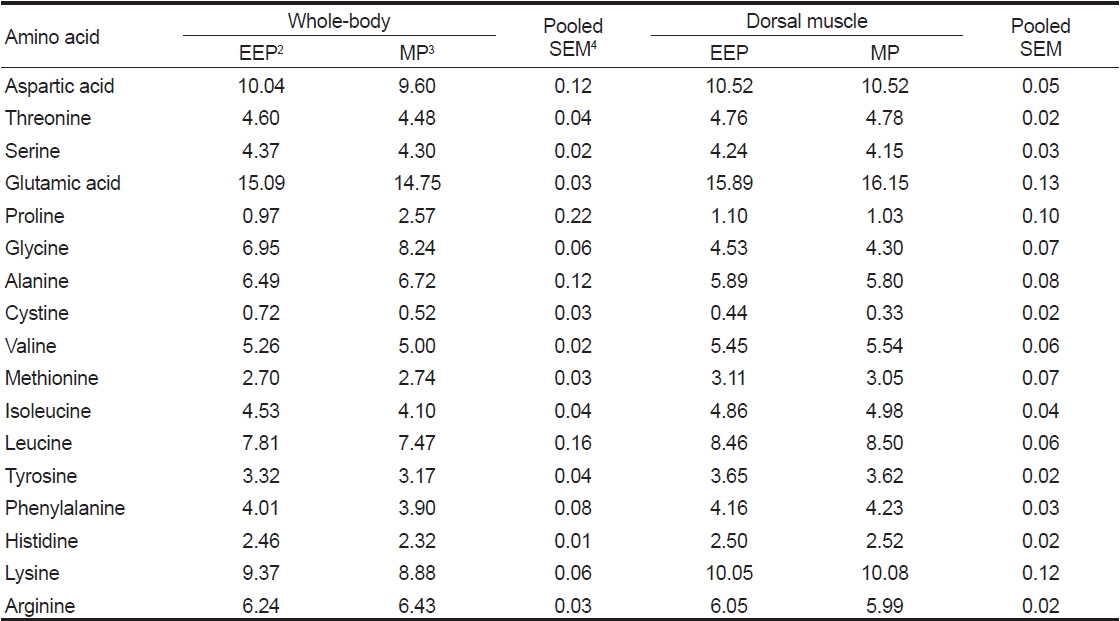
Amino acid contents of the whole-body and dorsal muscle for olive flounder Paralichthys olivaceus fed the experimental diets (% to total amino acid)1
배합사료와 습사료를 공급한 넙치 등근육의 물성평가 결과는 Table 9에 나타내었다. EEP 및 MP 실험구 간에 응집성, 경도, 강도 및 부착성을 평가한 결과 유의적인 차이를 보이지 않았다. 배합사료와 습사료의 물성평가는 전반적인 기호도와 근육의 경도 간에 밀접한 상관관계는 없었다. 이전에 보고된 연구결과를 살펴보면, Lee and Lee (1997)는 자연산 넙치 보다 양식산 넙치가 경도와 탄력성이 유의적으로 낮다고 보고 하였으며, Kim et al. (2010)은 배합사료와 습사료를 7개월간 급여하여 물성평가를 실시한 결과 본 연구결과와 유사하게 두 시험구 간에 유의적인 차이를 관찰할 수 없었다.

Textural properties of the dorsal muscle for olive flounder Paralichthys olivaceus fed the experimental diets1
이상의 연구결과를 종합해 보면, 본 연구에서 다양한 단백질 원료 및 첨가제를 조합하여 설계한 배합사료는 습사료와 비교하여 성장이 떨어지지 않고 대등한 성장률을 보였다. 또한 습사료의 공급은 전어체의 수분함량에 영향을 미치는 것을 알 수 있었으며, 등근육의 일반성분과 아미노산에는 영향을 끼치지 않았다. 배합사료의 공급은 전어체와 등근육의 지방산 조성에 영향을 미치는 것을 알 수 있었으며, 특히 다불포화지방산(PUFA)의 함량이 습사료 실험구 보다 유의적으로 높은 것을 알 수 있었다. 등 근육의 물성평가에서는 EP 및 MP 실험구에서 유의적인 차이를 관찰 할 수 없었다. 따라서 본 연구에서 설계한 배합사료는 MP 사료를 대체하여도 성장에 부정적인 영향을 끼치지 않을 것으로 보이며, 향후 배합사료 산업체에서 넙치용 배합사료를 설계하는데 활용될 수 있을 것으로 판단된다.









